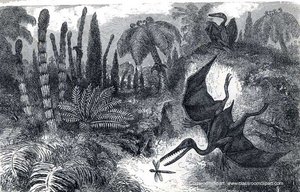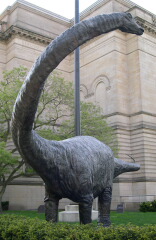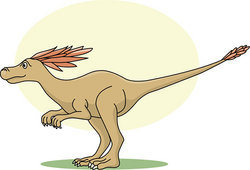Dinosaur
|
|
| Dinosaur Conservation status: Fossil | ||||||||
|---|---|---|---|---|---|---|---|---|
| Missing image Trex_skull.gif Skull of T. Rex from the U.S. Department of the Interior | ||||||||
| Scientific classification | ||||||||
| ||||||||
| Orders | ||||||||
Dinosaurs are animals that dominated the terrestrial ecosystem for over 100-million years. Non-avian dinosaurs became extinct 65 million years ago (Mya) at the end of the Cretaceous period. Dinosaurs are known from both fossils and nonfossils including fossilized bones, feces, trackways, gastroliths, feathers, impressions of skin and internal organs, and "soft tissues, including blood vessels and cells lining them [1] (http://www.nytimes.com/2005/06/03/science/03dinosaur.html)".
Since the first dinosaur was recognized in the 19th century, their mounted skeletons have become a major attraction at museums around the world. Dinosaurs have become a part of world culture, and have remained consistently popular, especially among children. They have been featured in bestselling books and blockbuster films like Jurassic Park, and new discoveries are regularly covered by the media. The term is also used informally to describe any prehistoric reptile, like the pelycosaur Dimetrodon, the winged pterosaurs, and the aquatic ichthyosaurs, plesiosaurs, and mosasaurs.
The on-going dinosaur renaissance [2] (http://www.arches.uga.edu/~rfreeman/GEOL3350_'4HistoryDinoSt.htm) started in the 1970s, and was triggered in part by John Ostrom's discovery of Deinonychus: an active, vicious predator which may have been warm-blooded (homeothermic), in marked contrast to prevailing image of dinosaurs as sluggish, cold-blooded reptiles. Vertebrate paleontology has also become global, with major new discoveries in previously unexploited regions, including South America, Madagascar, Antarctica, and most significantly the discovery of amazingly well-preserved feathered dinosaurs in China, which have further solidified the link between dinosaurs and their living descendants, the 9,000+ species of modern birds [3] (http://www.ucmp.berkeley.edu/diapsids/avians.html). The widespread application of cladistics, which rigorously analyzes the relationships between biological organisms, has also proved tremendously useful in classifying dinosaurs, which are still known from a spotty fossil record.
| Contents |
What is a dinosaur?
Definition
The superorder or clade "Dinosauria" was formally named by the English scientist Richard Owen in 1842. The term is a combination of the Greek words deinos ("terrible" or "fearfully great" or "formidable") and sauros ("lizard" or "reptile"). Contrary to popular perception, the name was chosen to express Owen's awe at the size and majesty of the extinct animals; not out of fear or trepidation at their size and formidable arsenal.
There is an almost universal consensus among paleontologists that birds are the descendants of theropod dinosaurs. Using the cladistic definition (all descendants of a single common ancestor), modern birds are dinosaurs, and dinosaurs are therefore not extinct:
"Ask your average paleontologist who is familiar with the phylogeny of vertebrates and they will probably tell you that yes, birds (avians) are dinosaurs. Using proper terminology, birds are avian dinosaurs; other dinosaurs are non-avian dinosaurs, and (strange as it may sound) birds are technically considered reptiles."
—DinoBuzz (http://www.ucmp.berkeley.edu/diapsids/avians.html) hosted by University of California Museum of Paleontology
Modern birds are classified by most palaeontologists as belonging to the subgroup Maniraptora, which are coelurosaurs, which are theropods, which are saurischians, which are ornithischians, which are dinosaurs.
However, birds are morphologically quite distinct from their reptilian ancestors, and referring to birds as "avian dinosaurs" and all other dinosaurs as "non-avian dinosaurs" is clumsy. Birds are still birds, at least in popular usage and among ornithologists. It is also technically correct, at least under the older Linnaean classification system, which accepts taxa that exclude some descendants of a single common ancestor (paraphyletic taxa). Paleontologists mostly use cladistics in their classifications, which does classify birds as dinosaurs, but many other scientists do not. As a result, this article hereafter uses "dinosaur" as a synonym for "non-avian dinosaur", and "bird" as a synonym for "avian dinosaur".
Capabilities and behaviours
Dinosaurs are extremely varied; some herbivorous, others carnivorous; some bipedal, others quadrupedal. For details on the various types of dinosaurs, see 'Classification' below.
Size
Only a tiny percentage of animals are ever fossilized, and most of those are still buried in the earth. As a result, the smallest and largest dinosaurs will probably never be discovered. Even among those that are recovered, very few are known from complete skeletons and even impressions of soft tissue like skin is very rare. So reconstructing a skeleton by comparing the size and morphology of the bones to the bones of similar, better-known species is inexact; and restoring the muscles and other organs is at best educated guesswork.
While the largest and smallest will probably remain unknown, and comparisons between existing specimens is imprecise, it is clear that as a group they were very large. But even by dinosaur standards the sauropods were gigantic. The smallest sauropods were larger than anything else in their habitat, and the largest were an order of magnitude more massive than anything else that has ever walked the Earth.
The tallest and heaviest dinosaur known from a complete skeleton is still the Brachiosaurus (now Giraffatitan) which was discovered in Tanzania between 1907–1912, and is now mounted in the Humboldt Museum of Berlin. It is 12 m (38 ft) tall, and probably weighed between 30,000–60,000 kg (30–65 tons). The longest is the 27 m (89 ft) long Diplodocus which was discovered in Wyoming, and mounted in Pittsburgh's Carnegie Natural History Museum in 1907.
There are bigger dinosaurs, but they are known from only a small handful of bones. The current record holders all date from the 1970s or later, and include the massive Argentinosaurus, which may have weighed 80,000–100,000 kg (90–110 tons); the longest, the 40 m (130 ft) long Supersaurus; and the tallest, the 18 m (60 ft) Sauroposeidon, which could have reached into a 6th-floor window.
No other group of terrestrial animals even comes close. The largest elephant on record weighed a mere 12,000 kg (13.5 tons), and the tallest giraffe was just 6 m (20 ft) tall. Even giant prehistoric mammals like the Indricotherium and the Columbian mammoth were dwarfed by the giant sauropods. Only a small handful of aquatic animals approach it in size, of which the blue whale is largest, reaching up to 190,000 kg (210 tons) and 33.5 m (110 ft) in length.
Discounting modern birds like the bee hummingbird, the smallest dinosaurs known were about the size of a crow or a chicken. The Microraptor, Parvicursor, and Saltopus were all under 60 cm (2 ft) in length.
Behavior
Interpretations of behavior based on the pose of a body fossil and its habitat, computer simulations of their biomechanics, and comparison with modern animals in similar ecological niches rely on speculation and promise to generate controversy for the foreseeable future. However, it is likely that at least the behaviors common in both of their closest living relatives, crocodiles and birds, are also common among dinosaurs.
The first evidence of herding behavior was the 1878 discovery of 31 Iguanodon that perished together in Bernissart, Belgium [4] (http://www.dinohunters.com/Iguanodon/bernissart_page.htm), and similar mass deaths and trackways suggest that herd or pack behavior is common among many dinosaur groups. Trackways of hundreds or even thousands of herbivores indicate that duck-bills (hadrosaurids) may have moved in great herds, like the American Bison or the African Springbok. Sauropod tracks document that they traveled in groups composed of several different species, at least in Oxford, England [5] (http://news.nationalgeographic.com/news/2002/05/0529_020529_sauropods.html), and others kept their young in the middle of the herd for defense according to trackways at Davenport Ranch, Texas. Dinosaurs may have congregated in herds for defense, migration, or to care for their young.
Jack Horner's 1978 discovery of a Maiasaura ("good mother dinosaur") nesting ground in Montana demonstrated parental care long after birth among the ornithopods [6] (http://www.isgs.uiuc.edu/faq/dino-faqs/pdq76.html) [7] (http://www.browningmontana.com/dinosaurs.html), and similar nesting behavior and even huge nesting colonies like those of penguins have been discovered of other Cretaceous dinosaurs like the Patagonian sauropod Saltasaurus (in 1997). The Mongolian maniraptoran Oviraptor was even discovered in a chicken-like brooding position in 1993, which may mean it was covered with an insulating layer of feathers that kept the eggs warm [8] (http://search.eb.com/dinosaurs/dinosaurs/BRa.html). Trackways have also confirmed parental behavior among sauropods, and ornithopods from the Isle of Skye in the United Kingdom [9] (http://news.bbc.co.uk/1/hi/scotland/3255494.stm). Nests and eggs are known from most major groups of dinosaurs, and it appears likely that dinosaurs communicated with their young, like modern birds and crocodiles.
The crests and frills of some dinosaurs, like the marginocephalians, theropods and lambeosaurines, may have been too fragile for active defense so they were probably used for sexual or aggressive displays, though little is known about dinosaur mating and territorialism. Communication is also an enigma, but the hollow crests of the lambeosaurines may have been resonance chambers, used for a wide range of vocalizations.
Theropods stalked their prey in Glen Rose, Texas [10] (http://www.tpwd.state.tx.us/park/dinosaur/), and a fossil of a Velociraptor attacking a Protoceratops was discovered in the Gobi Desert in 1971 [11] (http://www.amnh.org/exhibitions/fightingdinos/ex-fd.html). While cannibalistic behavior among theropods is no surprise [12] (http://news.nationalgeographic.com/news/2002/12/1219_021219_dinocannibal.html), it was confirmed by tooth marks from Madagascar in 2003 [13] (http://www.nsf.gov/od/lpa/news/03/pr0336.htm).
Compared to the later mammalian radiation in the Cenozoic, there seem to be no burrowing and few climbing dinosaurs.
Biomechanics has given insight into how fast dinosaurs can run [14] (http://palaeo.gly.bris.ac.uk/Palaeofiles/Tracks/Report7/Speed.html) [15] (http://www.shef.ac.uk/~es/DINOC01/dinocal1.html), whether diplodocids could create sonic booms by snapping their tails like a whip [16] (http://www.newscientist.com/article.ns?id=mg15621103.900), whether giant theropods had to slow down to avoid fatal belly-flops [17] (http://news.bbc.co.uk/1/hi/sci/tech/78905.stm), and if sauropods could float [18] (http://www.nserc.ca/news/features/dinosaurs_e.htm).
Scientific study
Fields of study
Information on dinosaurs is gained from a variety of fields of study including Physics, Chemistry, Biology, and the Earth Sciences (which includes Paleontology).
Activities include the discovery, reconstruction and conservation of dinosaur fossils and the interpretation of those fossils to understand better the evolution, classification and behaviour of dinosaurs.
Evolution
Dinosaurs split off from their archosaur ancestors during the Triassic period.
The first known dinosaurs appeared approximately 230 Ma, about 20 million years after the Permian-Triassic extinction event wiped out about 70 percent of all biological diversity on the planet. A few lines of primitive dinosaurs diversified rapidly after the Triassic, and quickly expanded until they filled most of the vacant ecological niches. During the reign of the dinosaurs, which encompassed the ensuing Jurassic and Cretaceous periods, every terrestrial animal larger than 1 m in length was a dinosaur.
The Cretaceous-Tertiary extinction event, 65 Ma at the end of the Cretaceous, caused the extinction of all dinosaurs, except for the line that had already led to the first birds.
Classification
Main article: Dinosaur classification
Dinosaurs are archosaurs, like modern crocodylians. These are set apart by having diapsid skulls, having two holes where jaw muscles attach, called temporal fenestrae. Birds and most reptiles are diapsids; mammals, with only one temporal fenestra, are called synapsids; and turtles, with no temporal fenestra, are anapsids. Dinosaurs also have teeth that grow from sockets (an archosaur characteristic), rather than as direct extensions of the jaw bones, as well as various other characteristics. Within this group, the dinosaurs are set apart most noticeably by their gait. Instead of legs that sprawl out to the side, as found in lizards and crocodylians, they have legs held directly under their body.
Many other types of reptiles lived at the same time as the dinosaurs. Some of these are commonly, but incorrectly, thought of as dinosaurs: these include plesiosaurs (which are not closely related to the dinosaurs), and pterosaurs, which developed separately from reptilian ancestors in the late Triassic.
Dinosaurs are divided into two major orders, the Saurischia and the Ornithischia, on the basis of hip structure.

Ornithischia.png
Saurischians
Main article: Saurischia
Saurischians (from the Greek, meaning "lizard hip") are dinosaurs that retained the hip structure of their ancestors. They include all the theropods (bipedal carnivores) and sauropods (long-necked herbivores).
Ornithischians
Main article: Ornithischia
Ornithischians (from the Greek, meaning 'bird-hip') is the other dinosaurian order, most of which were quadrupedal herbivores.
Areas of debate
Warm-blooded?
Scientists have waged a constant and vigorous debate over the temperature regulation of dinosaur blood— at first over its possibility, then over its method— a debate first popularized by Robert T. Bakker. From the first discovery of dinosaurs, paleontologists posited that they were ectothermic creatures: "terrible lizards" as their name suggested. This axiomatic expectation implied that dinosaurs were mostly slow, sluggish organisms, comparable to modern reptiles, which need the sun to heat their bodies. However, new evidence of dinosaurs in chilly temperate climates, of polar dinosaurs in Australia and Antarctica, where they experienced a six-month chilly and dark winter, of feathered dinosaurs whose feathers provided regulatory insulation, and analysis of blood-vessel structures that are typical of endotherms within dinosaur bone, confirmed the possibility that some dinosaurs regulated their body temperature by internal biological methods, some aided partly by their very bulk. Skeletal structures suggest active lifestyles for theropods and other creatures, behavior more suitable for an endothermic cardiovascular system. Sauropods exhibit fewer endothermic characters. Perhaps some dinosaurs were endothermic and others not. Scientific debate over the details continues, although many paleontologists would now agree that endothermic systems are more likely.
Complicating this debate, warm-bloodedness can emerge from more than one mechanism. Most discussions of dinosaur endothermia compare them to average birds or mammals, which expend energy to elevate body temperature above that of the environment. Small birds and mammals also possess insulation of some sort, such as fat, fur, or feathers, to slow down heat loss. However, large mammals, such as elephants, face a different problem due to their relatively small surface area to volume ratio (Haldane's principle). This ratio compares the volume of an animal with the area of its skin: as an animal gets bigger, its surface area increases more slowly than its volume. At a certain point, the amount of heat radiated away through the skin drops below the amount of heat produced inside the body, forcing animals to use additional methods to avoid overheating. In the case of elephants, they lack fur, and have large ears which increase their surface area, and have behavioural adaptations as well, such as using the trunk to spray water on themselves and mud wallowing. These behaviours increase cooling through evaporation.
Large dinosaurs would presumably have faced the same situation: their size would dictate that they lost heat relatively slowly to the surrounding air, and so could have been what are called bulk endotherms, animals that are warmer than their environments through sheer size rather than any special adaptations like those of birds and mammals.
Feathered dinosaurs and the bird connection
Main article: Feathered dinosaurs
The first good specimen of a "feathered dinosaur" was the 1861 discovery of the Archaeopteryx in Germany, in the Solnhofen limestone, which is a lagerst䴴e; one of the rare and remarkable geological formations known for their superbly detailed fossils. Coming just two years after Darwin's seminal The Origin of Species, the evidence of a transitional fossil between reptiles and birds spurred the debates between evolutionary biology and creationism. This early bird is so dinosaur-like that, without a clear impression of feathers in the surrounding rock, the specimens are commonly mistaken for Compsognathus.
Since the 1990s, a number of feathered dinosaurs have been found, providing clear evidence of the close relationship between dinosaurs and birds. Most of these specimens were local to Liaoning province in northeastern China, which was part of an island continent in the Cretaceous. However, the feathers were only preserved by the lagerst䴴e of the Yixian Formation; it is therefore possible that dinosaurs elsewhere in the world may have been feathered too, even though the feathers have not been preserved.
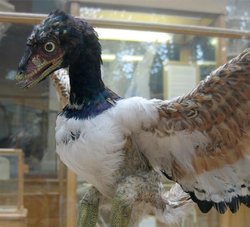
The feathered dinosaurs discovered so far include Beipiaosaurus, Caudipteryx, Dilong, Microraptor, Protarchaeopteryx, Shuvuuia, Sinornithosaurus, and Sinosauropteryx; and dinosaur-like birds like Confuciusornis; all of which come from the same area and formation in northern China. The dromaeosauridae family in particular seems to have been heavily feathered, and at least one dromaeosaurid, Cryptovolans, may have been capable of flight.
Because feathers are often associated with birds, feathered dinosaurs are often touted as the missing link between birds and dinosaurs. However, the association of multiple skeletal features also shared by the two groups is the more important link for paleontologists. Furthermore, it is increasingly clear that the relationship between birds, dinosaurs and the evolution of flight is more complex than has been previously realised. For example, while it was once believed that birds simply evolved from dinosaurs and went their separate way, some scientists now believe that some dinosaurs, such as the dromaeosaurs, may have actually evolved from birds, losing the power of flight while keeping the feathers in a manner similar to the Ostrich and other ratitess.
A recent discovery in a Tyrannosaurus rex skeleton provided more evidence that dinosaurs and birds evolved from a common ancestor and for the first time allowed palentologists to sex a dinosaur. When laying eggs, female birds have a special type of bone, called a medullary bone, that grows in their limbs, forming a layer inside the hard outer bone. It is rich in calcium and used for making eggshells. The presence of endosteally derived bone tissues lining the interior marrow cavities of portions of the Tyrannosaurus rex specimen's hindlimb elements suggested similar reproductive strategies, and revealed the specimen to be female (Schweitzer et al, 2005).
Extinction theories
Main article: Cretaceous-Tertiary extinction event
The extinction of the non-avian dinosaurs is one of the most intriguing problems in paleontology. Only since the 1980s has the nature of this extinction become apparent. The theory first proposed by Walter Alvarez linked the extinction event at the end of the Cretaceous period to a bolide impact about 65.5 Ma, based on a sudden change in Iridium levels in fossilized layers. The bulk of the evidence now indicates that a 10-kilometer-wide bolide hit the Yucatan Peninsula 65 Ma, creating the 170 km wide Chicxulub Crater, and caused the extinction. Scientists are still disputing whether dinosaurs were in steady decline or still thriving before the meteor struck.
Although the speed of extinction cannot be deduced from the fossil record alone, the latest models suggest the extinction was extremely rapid. It appears to have been caused by heat caused by the meteorite impact and the matter ejected from the crater re-entering the Earth's atmosphere around the world. Other theories link the extinction with increased volcanic activity, decreasing oxygen level in the atmosphere and dropping temperatures.
Other groups as well as the dinosaurs went extinct at the same time, including ammonites (nautilus-like mollusks), mosasaurs, plesiosaurs, pterosaurs, herbivorous turtles and crocodiles, most kinds of birds, and many groups of mammals, became extinct.
Evidence for Cenozoic non-avian dinosaurs
It has been claimed that fossils from El Ojo, South America, represent remains of non-avian dinosaurs surviving the extinction and still thriving in the Paleocene epoch. There are also other sporadic claims of post-Cretaceous dinosaur fossils (even a very doubtful finding of dinosaur eggs as late as Eocene). While it is certainly not improbable that some scattered population of some (presumably small) dinosaur species could have survived at least some hundred year after the mass extinction, evidence now points to El Ojo (and most other) findings as Cretaceous fossils contaminating Paleocene strata. Nevertheless it is still theorized that some dinosaur population could have survived the main extinction event isolated in Antarctica, then being killed by the climatic change.
Bringing dinosaurs back to life
Main article: Molecular paleontology
There has been much speculation about the availability of technology to bring dinosaurs back to life. The idea proposed in Michael Crichton's book Jurassic Park, using blood from fossilized mosquitos that have been suspended in treesap since the Mesozoic and then filling in the gaps with frog genes to create the DNA of a dinosaur, is probably impossible. The main problem is that DNA decays over time by exposure to air, water and radiation. Decay can be measured by a racemization test.
There have been two claims about the successful extraction of ancient DNA from dinosaur fossils, but upon further inspection, neither of these reports could be confirmed (Wang et al., 1997). However, a working visual peptide of a (theoretical) dinosaur has been inferred, using analytical phylogenetic reconstruction methods on gene sequences of still-living related species (reptiles and birds) (Chang et al., 2002).
Discovery of probable soft tissue from dinosaur fossils
In the March 2005 Science magazine, Mary Higby Schweitzer et al. announced that material appearing to be soft tissue was discovered inside a Tyrannosaurus rex leg bone from the Hell Creek Formation in Montana, from about 68 million years ago.[19] (http://www.sciencemag.org/cgi/content/full/sci;307/5717/1952) The discovery was made when the team was transporting the fossil and reluctantly decided to break it for transportation by helicopter. Once the bone was broken, the apparent soft tissue was seen and the team decided not to apply the preservatives often immediately applied to excavated dinosaur fossils.
When the fossilised bone was treated over several weeks to remove mineral content (demineralise) from the fossilised bone marrow cavity, Schweitzer found evidence of intact structures such as blood vessels, bone matrix, and connective tissue (bone fibres). Scrutiny under microscope further revealed the putative dinosaur soft tissue had retained fine structures (microstructures) even at the cellular level. Round deep-red to dark brown ???? (resembling blood cells) in the blood vessels and elongated microstructures (resembling osteocytes) inside the bone matrix were found. Some apparent cells had dark spots in the centre similar to cell nuclei. More important was the fact that the tissue remained pliable and elastic. Schweitzer and colleages announced that it appeared "nearly identical" to analogous tissue taken from recently deceased ostrich leg bones.
Although this evidence appears to support the conclusion that the material was soft tissue from the T. rex, it was not completely clear how such material could retain its flexibility for 68 million years. Similar material from frozen – not fossilised – Mammoth bone is about 10,000 to 30,000 years old.
"The same T. rex has yielded unusual bone tissue that shows that the animal was an ovulating female. ... the estrogen-derived tissue was similar to substances now present only in living birds that produce eggshells. ... Medullary tissue, previously associated just with female birds, is formed by an increase in estrogen levels during a bird's egg-laying cycle and is deposited on the interior walls of the leg bones. The tissue serves as a reservoir of calcium for eggshells. After the last egg is laid, the tissue is completely reabsorbed into the bird's body. Dr. Schweitzer said the presence of such tissue in the T. rex indicated that the reproductive physiologies of some dinosaurs might have been similar those of to modern birds, in particular flightless ones like ostriches and emus." [20] (http://www.nytimes.com/2005/06/03/science/03dinosaur.html)
History
Dinosaur fossils have been known about for millennia, though their true nature was not recognised; the Chinese considered them to be dragon bones, while Europeans believed them to be the remains of giants and other creatures killed by the Great Flood. The first dinosaur species to be identified and named was Iguanodon, discovered in 1822 by the English geologist Gideon Mantell, who recognised similarities between his fossils and the bones of modern iguanas. Two years later, the Rev William Buckland, professor of geology at Oxford University, became the first person to describe a dinosaur in a scientific journal — in this case Megalosaurus bucklandii, found near Oxford. The study of these "great fossil lizards" became of great interest to European and American scientists, and in 1842 the English palaeontologist Richard Owen coined the term "dinosaur". He recognised that the remains that had been found so far — Iguanodon, Megalosaurus and Hylaeosaurus — had a number of features in common, so decided to present them as a distinct taxonomic group. With the backing of Prince Albert of Saxe-Coburg-Gotha, husband of Queen Victoria, Owen established the Natural History Museum in South Kensington, London, to display the national collection of dinosaur fossils and other biological and geological exhibits.
In 1858, the first known American dinosaur was discovered in marl pits of the small town of Haddonfield, New Jersey (although fossils had been found before, their nature had not been identified). The creature was named Hadrosaurus foulkii, after the town and the discoverer, William Parker Foulke. It was an extremely important find: Hadrosaurus was the first nearly complete dinosaur skeleton ever found and it was clearly a bipedal creature. This was a revolutionary discovery, as it had been thought by most scientists that dinosaurs walked on four feet like lizards. Foulke's discoveries sparked a dinosaur mania in the United States which was exemplified by the fierce rivalry of Edward Drinker Cope and Othniel Charles Marsh, who each competed to outdo the other in finding new dinosaurs in what came to be known as the Bone Wars. Their feud lasted for nearly 30 years and only ended in 1897 when Cope died after spending his entire fortune in the dinosaur hunt. Marsh won the contest by virtue of being better funded through the US Geological Survey. Cope's collection is now at the American Museum of Natural History in New York, while Marsh's is displayed at the Peabody Museum of Natural History at Yale University.
Since then, the search for dinosaurs has been carried to every continent on Earth. This includes Antarctica, where the first dinosaur, a nodosaurid Ankylosaurus, was discovered on Ross Island in 1986, though it was 1994 before an Antarctic dinosaur, the Cryolophosaurus ellioti, was formally named and described in a scientific journal. Current "hotspots" include southern South America (especially Argentina) and China, which has produced many exceptionally well-preserved feathered dinosaurs.
In popular culture
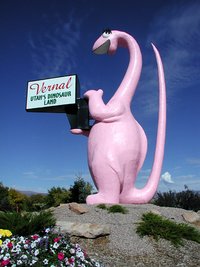
Dinosaurs were highly successful life forms for some 150 million years; however, even more than their success, it is their extinction that has become part of human culture. Hence dinosaur is sometimes used as a metaphor for people and things that are perceived as being out of date or no longer in touch with the spirit of the times, and therefore ought to be extinct. An example was the manner in which the punk movement described the "progressive" bands that preceded them as "dinosaur groups." Decentralized social movements have sometimes described centralized governments or corporations as dinosaurs as well.
Dinosaurs have long captured the public mind, and children are especially fascinated with them. This is evidenced by the many dinosaurs in fictional works. Notable examples include Arthur Conan Doyle's book The Lost World, the 1933 movie King Kong, and Michael Crichton's book Jurassic Park.
Even in the early days of cinematography a dinosaur could become a movie star, as was the case in 1914 with Gertie the Dinosaur by animation pioneer Winsor McCay. Further films used artistic license and showed humans as living contemporaries of dinosaurs. For example The Valley of Gwangi (1969) and One Million Years BC (1966) (famously starring Raquel Welch in a fur bikini). Ray Harryhausen brought the dinosaurs to life in both films using model animation.
In the age of computer-generated imagery stunningly realistic depictions of dinosaurs and other "prehistoric" animals became a possibility. In Jurassic Park dinosaurs are brought into contact with humans when they are genetically resurrected. The film based on this book was a big success in 1993.
Dinosaurs are also a frequent topic of television documentaries and popular, nonfiction books. A notable documentary using CGI was the 1999 BBC series Walking with Dinosaurs.
Dinosaurs are a common theme in popular comic strips such as Calvin and Hobbes and The Far Side. Dinosaurs are also commonly seen in children's television shows such as the 1970s show Land of the Lost, the more recent Barney & Friends, and in some of Toei's Super Sentai Series (which was Americanized into Power Rangers).
See also: List of fictional dinosaurs
See also
Dinosaur Clipart and Pictures
- Dinosaur Clipart (https://classroomclipart.com/clipart/Dinosaurs.htm)
Clipart and Animal Pictures
- Clipart (https://classroomclipart.com/image/category/clipart.htm)
- Animal Clipart (https://classroomclipart.com/image/category/animal-clipart.htm)
- Animal Animated Clipart (https://classroomclipart.com/clipart/Animations/Animals.htm)
- Pictures of Animals (https://classroomclipart.com/image/category/animal-photos.htm)
- Amphibian Clip Art, Pictures and Photogaphs (https://classroomclipart.com/image/category/amphibian-clipart.htm)
- Farm Animal Clip Art, Pictures and Photographs (https://classroomclipart.com/image/category/farm-animal-clipart.htm)
- Mammal Clip Art, Pictures and Photographs (https://classroomclipart.com/image/category/mammal-clipart.htm)
- Marine Animal Clip Art, Pictures and Photographs (https://classroomclipart.com/image/category/marine-life-clipart.htm)
- Reptile Clip Art, Pictures and Photographs (https://classroomclipart.com/image/category/reptile-clipart.htm)
- Spider Clip Art, Pictures and Photographs (https://classroomclipart.com/image/category/spider-clipart.htm)

